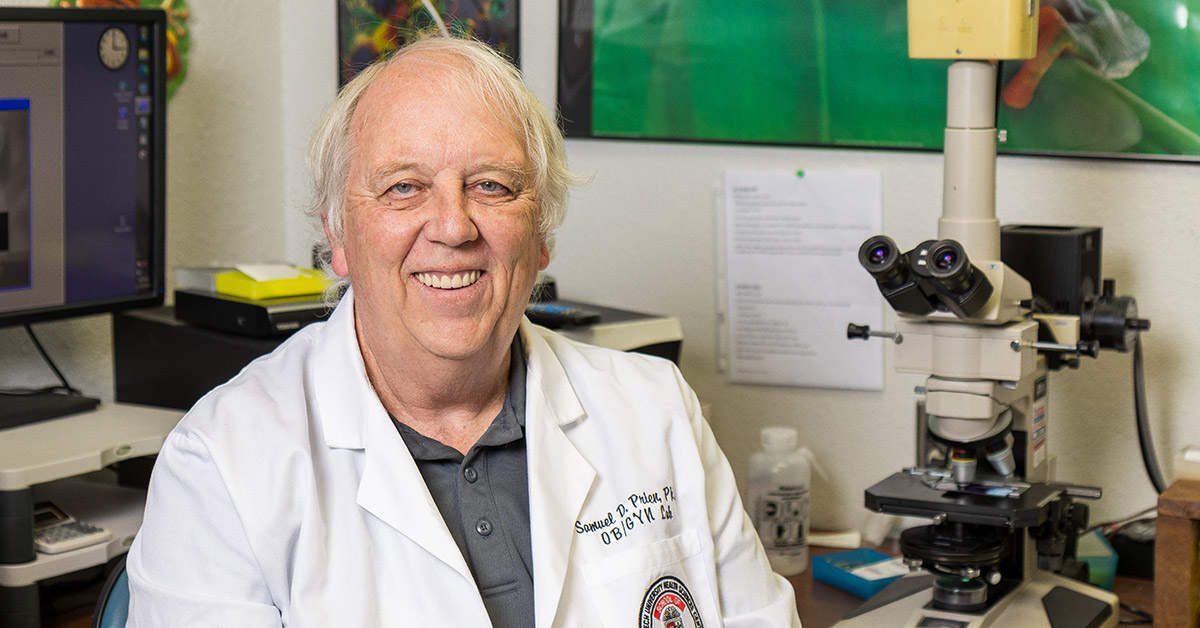Infertility Awareness Week marks 35 years of ART advancements

Sam Prien, Ph.D.
Infertility Awareness Week, April 21 through April 27, is a week devoted to raising awareness of the estimated one in six couples who suffer infertility issues. For those who work in the field of infertility treatment, the dedicated doctors, nurses, and, like me, the guys back in the lab, it is a time to reflect on where we have come from, where we are and where we hope to go.
This year has a special significance because it marked the 35th anniversary of the first birth from what has become known as assisted reproductive technologies (ART) associated with the infertility program at Texas Tech University Health Sciences Center (TTUHSC). That birth was approximately a decade after the first test tube baby was born in 1978. While the news surrounding this was not as earth-shattering, it made headlines from Lubbock to Dallas as the first baby conceived using high-tech procedures in West Texas. The fact that it made the news was a testament to how little progress was made in the first ten years of ART use in humans; almost every birth was a major announcement because pregnancy rates then were a dismal 7%.
In the 1990s, the world of infertility began to change with new techniques such as the single sperm injection technique and intracytoplasmic sperm injection (ICSI). These techniques, combined with more standardized treatment plans and better overall culture conditions in the laboratory, led to drastically higher pregnancy rates, which rose from 7 to 35% by the end of the last century to national and local rates approaching 50% in some patient populations. The procedure has become so routine that 2 to 3% of the annual birth rate in the U.S. is associated with infertility treatment.
These successes have not come without their growing pains, as what were wonderous birth announcements in the news now focus on clinic mistakes or accidents. However, ART treatment has become a safe and effective means for those with infertility issues. Newer techniques are allowing us to transfer embryos with the best chance of having a healthy pregnancy and healthy baby, lowering the number of procedures a couple has to undergo to take home the child they always wanted.
So, what is the future? In the 1990s, when the TTUHSC program had one of the highest take-home baby rates of about 30%, I was asked if I was proud. I answered, “No, that means two out of three couples are going home without a baby.” We are at 50% now, but that still means only half take home a baby though we have become better in certain areas of fertility treatment. For example, we now routinely transfer only a single embryo, which is why the birth of triplets, quadruplets, quintuplets, or more has become increasingly rare. Singleton pregnancies have much better outcomes. Yet, other areas, such as selecting the healthiest sperm from a population of millions, a focus of TTUHSC fertility research, and which might be the next major step in driving take-home baby rates up into the 60 to 70% range, still elude us.
Yes, Infertility Awareness Week is an excellent reminder of the many struggles faced by couples having difficulty conceiving. Well beyond the simple mechanical issues of conception, there are the financial and emotional issues these couples face along their fertility journey. Yet there are now many stories of success as improvements in ART lead to more couples taking home the babies they always wanted. After almost 40 years of continuous existence, the fertility program at TTUHSC has assisted in the conception and birth of thousands of children in West Texas. In fact, I’ve had the privilege of teaching numerous students at the university who were conceived with the help of our program. Some of them have even participated in our research to improve ART techniques. Life really does go full circle.
Sam Prien, Ph.D., is a professor and director of Clinical and Research Laboratories in the TTUHSC School of Medicine Department of Obstetrics and Gynecology. This editorial was written for and originally published by the Lubbock Avalanche-Journal.
Related Stories
TTUHSC Dean to be Inducted into the National Academies of Practice as Distinguished Fellow
Gerard E. Carrino, Ph.D., MPH, dean of the TTUHSC Julia Jones Matthews School of Population and Public Health, will be inducted into the National Academies of Practice (NAP) as a Distinguished Fellow of the Public Health Academy.
TTUHSC School of Nursing Celebrates 10-Year Anniversary of the Abilene Community Health Center
The TTUHSC School of Nursing hosted a 10-Year Anniversary Celebration and Open House for the Abilene Community Health Center. The center is one of 71 Federally Qualified Health Centers (FQHCs) in Texas according to the Texas Health and Human Services.
TTUHSC Receives $1.3 Million HRSA Telehealth Resource Center Grant to Expand Telehealth in Texas and Louisiana
The TexLa Telehealth Resource Center, based at TTUHSC, has been awarded a $1.3 million, four-year grant from HRSA to strengthen and expand digital health services in Texas and Louisiana.
Recent Stories
TTUHSC Cancer Researcher Honored by National Academy of Inventors
C. Patrick Reynolds, M.D., Ph.D., director of the School of Medicine Pediatric Cancer Research Center at TTUHSC, has dedicated his life as a researcher to developing treatments for childhood cancers.
TTUHSC School of Nursing Celebrates 10 Years of the Veteran to BSN Program
The TTUHSC School of Nursing recognized the 10-year anniversary of the Veteran to Bachelor of Science in Nursing (VBSN) program during the fall 2025 commencement ceremonies held Dec. 13 in Lubbock, Texas.
TTUHSC Dean to be Inducted into the National Academies of Practice as Distinguished Fellow
Gerard E. Carrino, Ph.D., MPH, dean of the TTUHSC Julia Jones Matthews School of Population and Public Health, will be inducted into the National Academies of Practice (NAP) as a Distinguished Fellow of the Public Health Academy.
